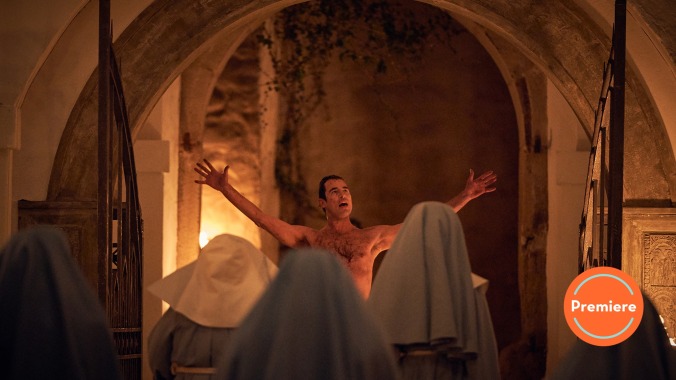Dracula explores the fine line between horny and clever


In the early going, Dracula has sex on the brain. The miniseries’s opening episode, “The Rules Of The Beast”, establishes the relationship between the count’s first victim, English lawyer Jonathan Harker, and his fiancé Mina Murray with a letter in which the latter playfully promises to take carnal vengeance with everyone back home should her beloved stray while in Transylvania. Sister Agatha, a nun serving as self-appointed investigator of Harker’s case, asks the ill-fated man whether his desiccated appearance is the consequence of having had sex with Dracula. She jokes another nun is sitting in on her interview with Harker because the convent doesn’t trust her with men and compares her tepid faith to being in a loveless marriage with the almighty. She assures Harker that dreams are a realm where one is free to sin without worry as we learn the count’s first attack, imagined or otherwise, came when he inserted himself into Jonathan’s dream of sex with Mina.
For those familiar with cowriters Steven Moffat and Mark Gatiss’s previous work, none of this should come as a surprise. These are writers who have never hesitated to ask of iconic characters, “What defines these legends, and why is it horniness?” Their previous collaboration Sherlock is fascinated with the sexual subtext of the great detective’s relationship with, well, damn near everyone. Moffat’s 2007 miniseries Jekyll, in which Gatiss put in a guest turn as original novel writer Robert Louis Stevenson, alternates in viewing Mr. Hyde as either sex or love incarnate. And then there’s Moffat’s time at the helm of Doctor Who, in which he shattered the show’s longstanding if previously teetering assumption that the Doctor is asexual.
Not that it takes much work to view the Dracula story, of all things, through that particular lens. Vampires were the horniest monsters long before Moffat and Gatiss turned their attention to the genre’s most iconic example. All the familiar signifiers of vampiric sexuality are here: the sensuality in each shot of a drop of blood, the staging of attacks as seduction, the animal virility of the count, and so on. If ever there were an ideal vehicle for Moffat and Gatiss to explore their storytelling obsessions—especially Moffat, given he wrote Jekyll and ran Doctor Who solo, though all the macabre and grotesque imagery feels like a testament to Gatiss’s equal partnership—then Dracula is surely it.
The big question for them is the same one that dogged all three of those previous effort: Can the miniseries resist the urge to prove how clever it is long enough to craft a compelling story and give its characters room to breathe? (Admittedly, for some of the characters that phrasing is more metaphorical than you would typically expect.) “The Rules Of The Beast” is promising in that regard. Unlike Jekyll or Sherlock, this doesn’t translate the 19th century source material to the present day, instead keeping the action in 1897. That instantly makes this is a more conventional adaptation, with the opening episode concerned with the Transylvania-set portions of the familiar story. Still, this isn’t a straight adaptation of Bram Stoker’s novel, but then that’s rarely been the case going back to F.W. Murnau and Bela Lugosi, both of whose films inspire the looks of Claes Bang’s Dracula in his various states. Bang is a lot of fun here, transforming as he feeds on Harker from wizened Eastern European other to swaggering Victorian lad. There’s some of Tom Ellis’s Lucifer in his performance, especially when we find Dracula trying to tempt any one nun into betraying the others while singularly unbothered by being naked out in the cold Hungarian night.
There are some specific allusions to the original book, including setting Jonathan and Mina’s reunion at a convent he has fled to, though that one faithful decision is in service of a half-dozen audacious departures. Generally, that’s a fair exchange. One of the episode’s two biggest departures from what we might call the consensus version of the story—the one everyone sort of knows, even if there’s no one single telling that has all of it—is to have Jonathan perish at Castle Dracula and come back as a creature of the undead. That choice here emphasizes Harker’s status as an almost worthy foe for the count, though the “almost” is heartbreaking. Jonathan recognizes quickly that something is very wrong in the castle, and his investigations lead him to discoveries even his monstrous host had missed. With his last breath, he swears he will do everything in his power to stop Dracula, and it’s only after he stops breathing that he proves unable to keep that promise.
While he’s destined to be upstaged in the subsequent episodes—Dracula does, after all, wear his skin as a mask to close out the episode, which only leaves so many places to go from there—Harker is the focus of the proceedings in the premiere. John Heffernan lends the part an appropriately Victorian mix of feckless presumption and quiet determination. He’s too pathetic to ever really threaten to be the hero of the piece, especially when his undead future lurks in the audience’s mind, but he has a palpable desperation to prove he is more than just the hapless victim. Harker has just enough spirit for it to make sense when Dracula applauds his resurrection, even as it’s clear that the count’s real foe is waiting for him at the Hungarian convent.
That’s the other big innovation of this version, as the scholar Abraham van Helsing becomes Sister Agatha van Helsing. The gender flip is the least radical aspect of her character, as it’s in her that Moffat and Gatiss center most of the cleverness. Her attitude and lines walk right up to the edge of anachronistic, with the show trusting Dolly Wells to craft a performance that feels like more than a big bag of writerly choices. This is less successful during her interview with the undead Harker, as this feels a little too much like a self-consciously clever genre excursion into police show territory. However, once she is matched with Dracula herself, the character snaps into sharper focus. Her resolve and confidence remain, but she recognizes just how powerful a threat the vampire is, so there’s more of a context for her reactions. She is prepared to take big risks, including testing the legend that a vampire may only enter a residence when invited by opening the convent gate to a naked, ravenous Dracula to see if he can come through.
This is also where we start to see Dracula’s take on vampire lore. Moffat in particular loves taking an iconic work’s familiar tropes and tilting them. Here, Dracula’s condition is just a more advanced form of undeath, a condition that can affect any unfortunate who assumes they have died and finds their consciousness lingering on in the grave. Sister Agatha presents that to Jonathan so matter-of-factly it’s hard to judge whether that’s a significant clue or just a piece of macabre world-building.
Of far more definite importance are the rules governing vampire behavior, particularly the question of why crosses work to ward off Dracula. Moffat has long loved banking the profundity of his work on a single line that recontextualizes what we thought we understood about the story. For instance, he’s twice offered a revisionist definition of what love is at the climax of a story. (In Jekyll and Doctor Who’s “Death In Heaven”, for those curious, and they are dramatically different takes.) He has never wanted for big clever ideas a writer—presenting Jonathan’s condition as a venereal disease is, if not wholly original given the genre’s historical connotations, a particularly well-executed bit of business. But he and Gatiss do so insist on gambling a story’s thematic success on that one big reveal, and their track record has been mixed, even to someone like me who is generally a fan. The first big confrontation between Dracula and Sister Agatha concludes with him taunting her that she’s not as clever as she thinks she is. The big question now, as ever with this creative team, is whether the same will prove true for Dracula.
Stray observations
- Welcome to our coverage of this three-part miniseries. Look out for the next two reviews at 1 p.m. Eastern Sunday and Monday. The entire series is already available on Netflix in the United States—and the whole thing has aired on the BBC in Britain—but I’m watching and writing about one episode at a time, for those wanting to follow along.
- I tried to acknowledge this in the body of the review, but it’s worth reiterating. There’s a historical tendency to elide Mark Gatiss’ creative contributions when talking about shows like this and Sherlock, which isn’t really fair but is understandable given how of a kind so many of the creative choices of those shows feel of a kind with Moffat’s approach to Doctor Who and, more obscurely but just as relevantly, Jekyll. My convention is generally going to be to credit both equally, especially as unlike in Sherlock they are the credited co-writers for all three episodes, and any singling out of Moffat will be when I’m making a specific connection to his solo works. The same applies to Gatiss, honestly, especially given his career-long fascination with Hammer horror.
- I should also say that I don’t believe I’ve read Dracula, though I have seen the Lugosi movie and Murnau’s Nosferatu. I’ve tried to do my research on the various versions and point out some connections I come across, but I’m not the person to really assess the finest points of how it plays with the original novel.
- Any sensible person would assume that Sister Agatha’s reference to a detective friend in London is a reference to Sherlock Holmes. I am not a sensible person.
- Having watched the show as background for reviewing this, I have to ask: Any other Jekyll-heads around??